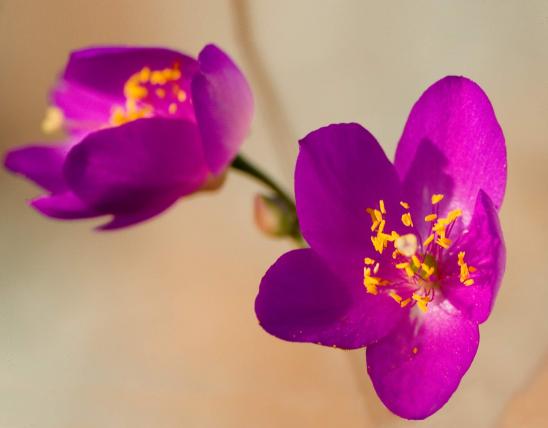
Purple poppy mallow is a sprawling, native perennial wildflower with bright magenta petals.
The stems spread across the ground and have ascending tips. Leaves and stems have stellate (star-shaped) and simple hairs (use magnification). The leaves are mostly circular in overall outline, deeply palmately lobed with 3 or 5 lobes that are irregularly pinnately lobed or toothed. Stipules (a pair of small leaflike structures) occur where leaves attach to the stem.
The flowers are 1½–2 inches wide. The calyx (sepal) lobes are strongly veined, with the veins raised and often whitish. Beneath the calyx, there are 3 leafy bracts that resemble the calyx lobes. Petals 5, wine red to purplish red, sometimes with a lighter area toward the base. Stamens numerous, with the filaments united to form a column surrounding the single pistil. Base of pistil forms a ring comprising numerous flattened, wedge-shaped sections. Blooms May–August.
Similar species: Four other species of poppy mallows, or wine cups, have been recorded for Missouri:
- Bush’s poppy mallow (C. bushii) is scattered in the southwestern quarter of the state north to Carroll County and east to Pulaski County; occurs in bottomland forests to dry upland forests, bottomland prairies, upland prairies, and calcareous glades; also roadsides, road cuts, railroads, pastures, and open, disturbed areas. It is sometimes confused with purple poppy mallow. Note differences in growth habit and bud tip characters: Bush’s poppy mallow has ascending stems (while purple poppy mallow has spreading stems with ascending tips); and the buds of Bush’s poppy mallow have the sepal tips joined to form a beaklike projection about ¼ inch long or more (while purple poppy mallow’s sepal tips, in bud, are free and somewhat spreading, not joined like a beak). Also, the calyx (sepal) lobes of purple poppy mallow are strongly veined, with the veins raised and often whitish, while those of Bush’s poppy mallow are not. Under magnification, the hairs of the basal leaves are mostly simple (while those of purple poppy mallow include many stellate, or star-shaped hairs).
- Fringed poppy mallow (C. digitata), also called finger poppy mallow or finger wine cup, is named for its deeply and very narrowly lobed leaves. Another identifying characteristic is that the calyx (conjoined sepals) is not subtended by small bracts (in Missouri poppy mallows, the only other one with this characteristic is pink poppy mallow, which has much paler flowers). It is scattered in the western part of the Ozarks and in northwestern Missouri; it also occurs (introduced) in Boone and Clay counties; dry upland forests, upland prairies, and calcareous glades; also roadsides and railroads.
- Pink poppy mallow (C. alcaeoides), also called pale poppy mallow or plains poppy mallow, is easily distinguished from the others because its petals are nearly white to light pink or pale lavender. Its racemes are sometimes so condensed as to appear as stalked clusters or umbels; the calyx (conjoined sepals) is not subtended by small bracts. It is scattered mostly in the western half of Missouri and has been introduced at scattered locations elsewhere in the state, but apparently absent from the Bootheel lowlands. Occurs in dry upland forests, upland prairies, and calcareous glades; also stream banks, roadsides, railroads, old quarries, and pastures.
- Clustered poppy mallow (C. triangulata), in Missouri, has been found only in sand prairies or roadsides in Mississippi and Scott counties (southeastern Missouri), but those populations seem to have disappeared. Except in Illinois, this species is of conservation concern nearly everywhere it occurs. Its stem leaves are triangular or heart shaped, without deeply lobed or deeply toothed margins. The flowers are arranged in panicles (appearing as clusters), not racemes.
Stem length: 2–20 inches. Overall plant spreads to about 3 feet; height to about 1 foot.
Scattered in northwestern Missouri east to Putnam County, also introduced nearly throughout the state, but apparently absent from the Bootheel lowlands and northeastern Missouri. Can be grown statewide in native wildflower gardens.
Habitat and Conservation
Occurs in upland prairies, roadsides, pastures, and other open, disturbed areas. Note that some of the other species of poppy mallows have slightly different (broader) habitat preferences.
Status
Native wildflower often used in landscaping.
Is it a poppy or a mallow? It is a mallow. At a glance, the flowers resemble small poppies. But a closer look at the center of the flower shows the characteristic structures of mallows: numerous stamens whose filaments are joined into a tubular column surrounding the single tall pistil — just as in other mallow-family flowers such as hibiscus, okra, and cotton.
Human Connections
Purple poppy mallow’s bright magenta flowers, spreading habit, and tolerance for drought and shallow, rocky soils make it a popular choice for pollinator-friendly native wildflower gardening. As always, make sure you obtain native flowers from a reputable native wildflower nursery. Never dig them from the wild (plus, wild specimens are difficult to transplant successfully).
Native Americans historically used a decoction of the roots as a pain reliever. The roots of all the perennial species of poppy mallows are both edible and palatable. Native Americans and early European travelers ate them in the Great Plains and southern states.
The genus name, Callirhoe, comes from Greek mythology. Callirhoe was a daughter of the river god Achelous, and she appears in a variety of convoluted tales.
Thomas Nuttall (1786–1859) is the botanist who named the plant genus. He led a fascinating life; his collecting expeditions in the western United States (including Missouri) after the Louisiana Purchase contributed greatly to scientific knowledge.
Ecosystem Connections
Bees are the principal pollinators. Numerous animals eat the foliage, ranging from caterpillars to woodchucks, rabbits, and deer.
Purple poppy mallow is one of many North American prairie wildflowers. Prairies are Missouri’s native, treeless grasslands and host a breathtaking variety of plants and animals. There are very few prairies left, although before European settlement, more than a third of the state was covered with them.






































